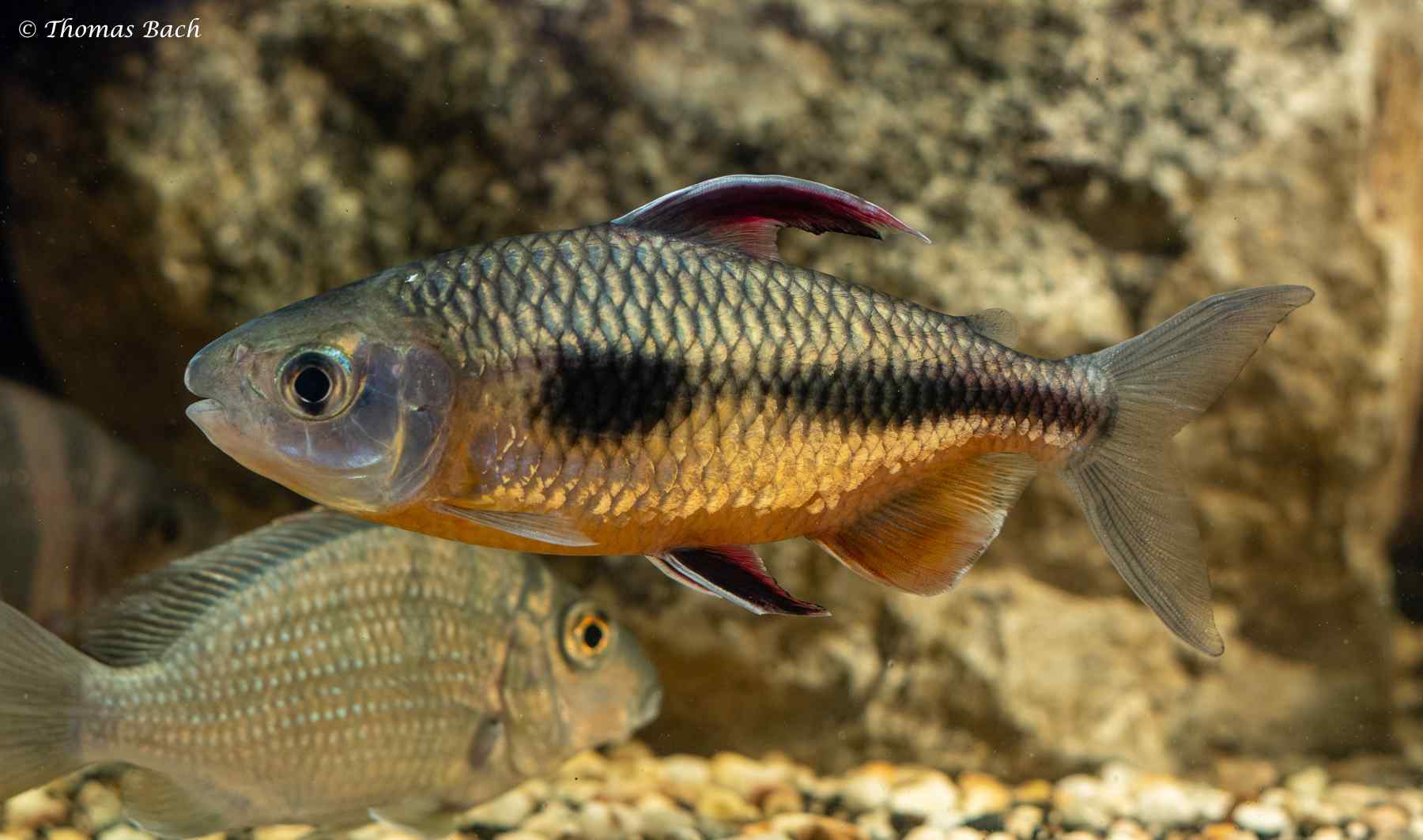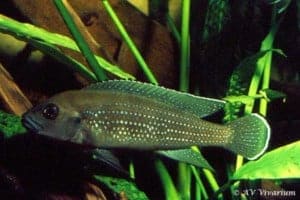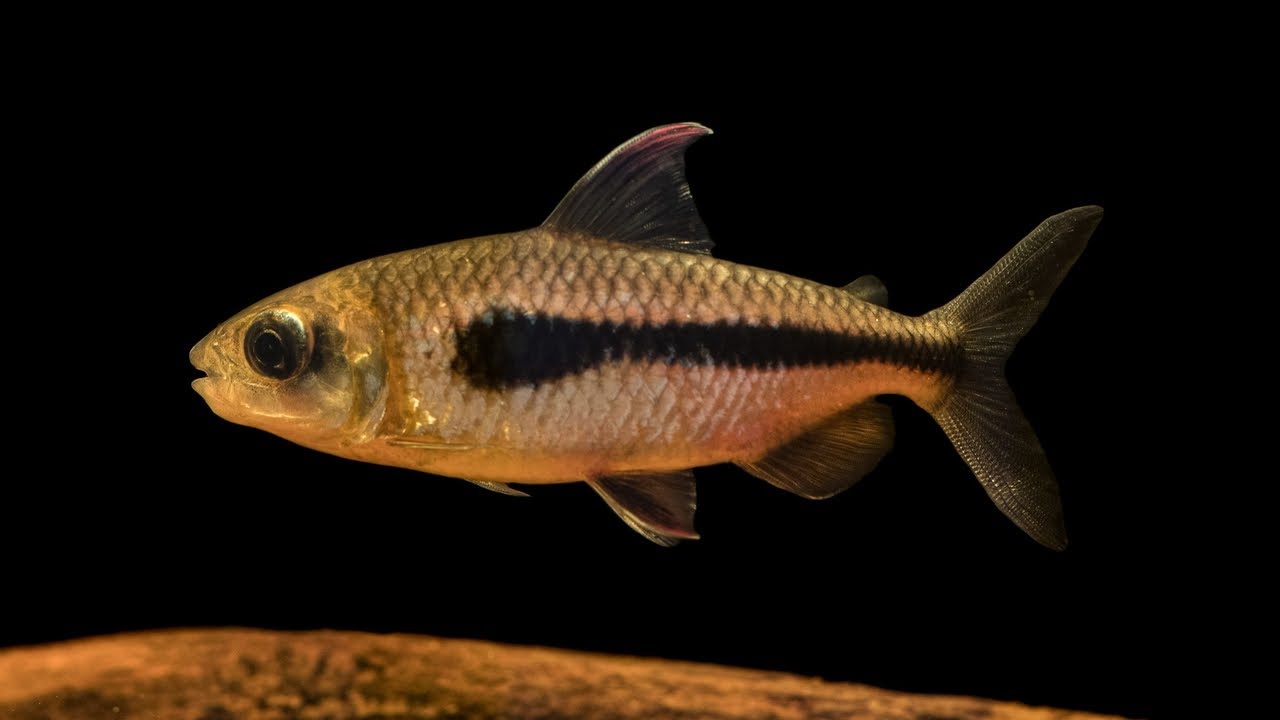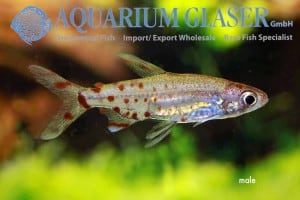Bryconaethiops boulengeri
Bryconaethiops boulengeri was first described by Pellegrin in 1900. Their common name in English is Boulenger’s Featherfin Tetra. The species is called “Tétra point d’exclamation” in French and “Tetra Lotombe” in Portuguese. Loosely translated, this means “Exclamation Mark Tetra.”
This fish belongs to the family of African Tetras, or Alestidae (formerly classified under Characidae).
The genus name Bryconaethiops is derived from the Greek word bryko, meaning “to bite,” and Aethiops, referring to a region in Northeast Africa. The name can therefore be interpreted as “African biter” or “African Tetra.” The species name boulengeri is a tribute to the renowned Belgian-British zoologist George Albert Boulenger, who contributed greatly to ichthyology (the study of fish).
Synonym: Bryconaethiops microstoma boulengeri.
Description
Bryconaethiops boulengeri is a striking fish with a streamlined body and an active swimming style. This fish has an elongated, sturdy body and a distinctive forked tail fin. The base color of the body is predominantly silvery. What immediately stands out are the distinct, interrupted black lateral line markings that run across the flanks and form a unique pattern. The fins are generally translucent, which contributes to the elegant and shiny appearance of the fish.
Bryconaethiops boulengeri can reach a maximum total length of approximately 25 centimeters.
Differences between males and females
Distinguishing between males and females in this species is subtle and not extensively documented, which is common with many tetras. In general, males are often slightly slimmer and may display more intense colors, especially during the breeding season. Females tend to have a fuller body, especially when they are carrying eggs (gravid), which indicates that they are ready to spawn. Both sexes have the characteristic silver body with black lateral line markings. The differences in body shape and slight variations in color intensity are the main indicators of sex. Males may also have a pink tint on their anal and pectoral fins. By observing them closely during feeding and social interactions within a group, the differences between males and females can become more apparent.
Behavior and temperament
Bryconaethiops boulengeri is a peaceful fish, making it suitable for a community aquarium with other larger, peaceful fish. Although they are not aggressive, they may chase smaller fish that are considered food. It is an active and fast schooling fish that feels most comfortable in groups of at least 5 or 6 specimens. When kept alone, they may show signs of stress or discomfort. They swim mainly in the middle to upper zone of the aquarium.
Life expectancy
The average life expectancy of Bryconaethiops boulengeri in an aquarium is up to 5 years.

Berlin Zoo
Biotope
Bryconaethiops boulengeri is a fish that occurs mainly in the freshwater environments of Central Africa. Its natural habitat is characteristic of river systems in tropical areas.
This species is widespread in the Congo Basin. Specific locations where the fish has been found include the Djiri River in Congo Brazzaville, which is a tributary of the right bank of the Congo River. The fish is also found in the Alima River and the Léfini River. Studies of its feeding habits have also been conducted in the regions of Lake Tumba and Ikela.
Description of the natural habitat (vegetation, banks, substrate): The Djiri River, a typical habitat for this fish, is characterized by the absence of severe periods of flooding and low water levels. This indicates a relatively stable river environment. The stomach contents of the fish show that they consume plant debris (macrophytes, dicotyledonous leaves, and other plant waste) and sometimes sand. This suggests that their habitat contains some vegetation and a substrate of sand and organic material.
Climate: The habitat of Bryconaethiops boulengeri has a tropical climate with distinct rainy and dry seasons. However, the Djiri River, where the fish have been studied, does not experience extreme flooding or droughts. This results in a diet that does not change significantly between the dry and rainy seasons.
Diet
Bryconaethiops boulengeri is an opportunistic eater that in the wild mainly focuses on insects, but does not shy away from other available food. Fortunately, in the aquarium, this fish is less picky and accepts a wide range of foods.
Food in the wild: In its natural habitat, Bryconaethiops boulengeri is primarily an insectivore (entomophagous) and is described as an “eclectic insectivore.” This means that it consumes both terrestrial (land) and aquatic (water) insects. The stomach contents of specimens studied showed that the main prey are insects, particularly beetles (Coleoptera), dragonfly larvae (Odonata larvae), and mayflies (Ephemeroptera). These insects make up a very large part of their diet, with a weight index of over 90%. In addition to insects, Bryconaethiops boulengeri also eats “anything that falls into the water,” such as bird feathers, plant debris (macrophytes, dicotyledonous leaves, and other plant waste), and fruit. Sand is also sometimes found in the stomach contents. The composition of the diet does not change significantly between the dry and rainy seasons, indicating a constant availability of food sources in their habitat.
Food in the aquarium: In an aquarium environment, Bryconaethiops boulengeri is an omnivore and accepts most types of food. This includes dry food such as pellets and flakes. They also appreciate live and frozen food, such as mosquito larvae and daphnia. Live shrimp and worms are particularly appreciated. It is recommended to feed them once or twice a day.
The Aquarium
Keeping Bryconaethiops boulengeri in an aquarium requires careful planning to mimic their natural habitat as closely as possible. This active schooling fish has specific needs to feel comfortable and exhibit its natural behavior
For a group of Bryconaethiops boulengeri, a minimum aquarium size of 200 centimeters in length is recommended to provide sufficient swimming space. A larger aquarium is always better for these active swimmers.
As they are schooling fish, they feel most comfortable in groups of at least 5 or 6, but a group of 8 to 10 fish will stimulate their natural behavior even better. They need a long and spacious aquarium, as they are very active and use a lot of swimming space.
Aquarium setup
The aquarium setup should mimic their natural river habitat. This means that there must be good water flow and sufficient oxygen in the water. A sandy bottom is ideal, as it mimics their natural environment and is gentle on the fish. Floating roots and smooth stones can be used to create a natural and visually appealing environment, but it is important to maintain sufficient open swimming space for these fast and active fish. In addition, it is advisable to provide some hiding places using tall plants and driftwood. Lighting should be moderate; too much light can cause stress, while dimmed light can enhance their colors and create a more natural atmosphere.
Water parameters
Stable freshwater values are very important for Bryconaethiops boulengeri.
- pH value: The ideal pH value is between 6.0 and 8.0.
- General hardness (GH): A GH value between 5 and 20 is suitable.
- Temperature: The water temperature should be between 22 and 27 °C. Ensure a constant temperature within these ranges. As mentioned earlier, good water flow and sufficient oxygen are essential for the well-being of these fish.
Suitable and unsuitable tank mates
Bryconaethiops boulengeri is a peaceful fish and can coexist well with other larger, peaceful fish in a community aquarium. However, due to their hunting instinct, they may prey on smaller fish that are considered food.
- Suitable tank mates:
- Characids of similar size.
- Robust cichlids.
- Various catfish.
- Bottom-dwelling fish such as bichirs.
- They can also be kept with larger and semi-aggressive fish, as they are fast and active.
- Unsuitable tank mates:
- Very small fish that can be seen as prey.
Breeding Bryconaethiops boulengeri
Specific details on breeding the Bryconaethiops boulengeri in an aquarium are unfortunately very limited and not extensively documented. This makes setting up a targeted breeding program challenging and likely requires experimentation and close observation.
Particularities
Besides the already discussed aspects of the Bryconaethiops boulengeri, there are some interesting facts that give a deeper insight into this species.
Digestive system: A striking feature of the Bryconaethiops boulengeri is the structure of its digestive system. The fish has a thick-walled esophagus followed by a U-shaped stomach surrounded by pyloric cecum. An average of eight of these pyloric cecum are present, and the intestine itself is curled. What is further notable is that the intestine of the Bryconaethiops boulengeri is relatively short. The intestinal coefficient, a measure of the relative length of the intestine to body length, ranges between 0.71 and 1.29, with an average of 0.95 ± 0.48 . This short intestine is characteristic of carnivorous or insectivorous fish, which fits well with the diet of this species consisting mainly of insects.
Limited information: Another important peculiarity is the limited knowledge that still exists about this fish. Although studies have been conducted on feeding habits, among other things, researchers emphasize that very little information is yet available on the general biology, ecology and reproduction of the Bryconaethiops boulengeri. This means that many aspects of its life in the wild and its breeding in aquariums remain unexplored, and further research is desirable to fill these gaps in knowledge . For aquarium enthusiasts interested in keeping or breeding this species, this offers both a challenge and an opportunity to contribute to the knowledge of this fascinating African salmon.
Conclusion
Bryconaethiops boulengeri is a fascinating African Tetra from the family Alestidae, native to the vast Congo Basin. This silvery, streamlined fish can reach an impressive length of about 25 centimeters and is notable for its active swimming behavior and intermittent black markings along its flanks. In the wild it is a nimble insect eater, but in the aquarium it is happily an omnivore, accepting a varied diet of dry, live and frozen foods. It is a peaceful schooling fish that feels best in a group of at least five to six conspecifics, although it may see smaller fish as prey.
For aquarium enthusiasts considering keeping this species, the Bryconaethiops boulengeri is a challenging but rewarding choice. Because of its eventual size and active nature, a spacious aquarium of at least 200 centimeters is essential to provide adequate swimming space. A setup with a sandy bottom, floating roots and tall plants, combined with good water flow and stable water values (pH 6.0-8.0, GH 5-20, temperature 22-27 °C), mimics its natural river habitat. The breeding of this species in aquariums is still largely undocumented, making it an interesting project for the more experienced enthusiast eager to contribute to the knowledge of this special fish.
Video
Copyright images
Thomas Bach
Klaus Rudloff – Biolib.cz
Reference
Mikia, M., Mady-Goma Dirat, I., Tsoumou, A., & Vouidibio, J. (2018). Food habits of Bryconaethiops boulengeri Pellegrin, 1900 (Characiformes: Alestidae) of Djiri River Tributary of the Right Bank of Congo River. Open Journal of Ecology, 8, 510-521. DOI: https://doi.org/10.4236/oje.2018.89031
Author
Since I bought my first second-hand aquarium when I was twelve, I have always had one or more aquariums. I even converted a garage into a breeding room where I had 50 aquariums containing around 10,000 liters of water. At the moment, I have two aquariums: a 1,250-liter Tanganyika aquarium and a 250-liter community aquarium with plants. For the past 10 years, I have been working on this website as a writer and photographer.









